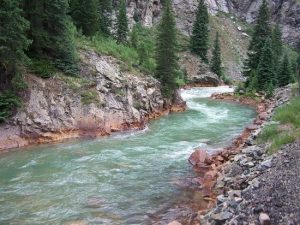
The Animas River winds through Colorado’s San Juan Mountains.
The Animas River, part of the Colorado River System, begins high in the San Juan Mountains of Colorado and winds all the way down to its confluence with the San Juan River in New Mexico. On our recent trip to the Four Corners region, Jacqueline and I seldom lost sight of the oftentimes breathtaking tributary, once known by the lengthier name of Rio de las Animas Perdidas—the River of Lost Souls.
WHERE WERE THE GHOSTS?
Our original goal being the Anasazi ruins in Mesa Verde National Park, we flew into the nearest city with an airport, which happened to be Durango, CO—located in the Animas River Valley. Yep, the river runs right through town. The city is home base to the Durango-Silverton Narrow Gauge Railroad, which takes riders on an awesome trip through the San Juan Mountains. More on that shortly. We explored some of Durango on foot, including the Main Avenue historic district—lots of old buildings, good restaurants, and the ubiquitous Starbucks, which made my bride extremely happy.
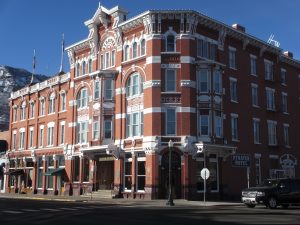
The Strater Hotel: haunted…or not?
In the midst of Main Avenue stands the venerable Strater Hotel. I just had to visit this place, given that it had been deemed the most haunted site in the state of Colorado by the Daily Meal website. I mean, hotel staff afraid to work on the upper floors? Apparitions all over the place? A “ghost diary” for guests in every room? Nope, some of the staffers told me, there’s nothing like that here. We can get the manager for you, but he’ll tell you the same thing. You want to buy a “ghost diary?” No, we don’t sell anything like that. Talk about denial… Major bummer for a guy like me who loves haunted places. Anyway, if you want to know where to go in your own state for some supernatural scares, here is a link to the article, “The Most Haunted Place in Each State.”
ECHOES OF RITUAL DRUMS
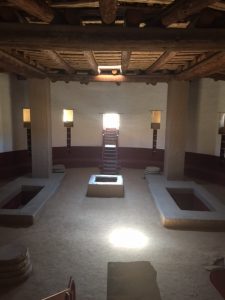
The restored Great Kiva at Aztec Ruins.
You can almost hear these drumbeats from centuries past as you sit in the Great Kiva at Aztec Ruins National Monument, the site of incredibly preserved Ancestral Puebloan structures from nearly a thousand years past. We followed Highway 550 along the Animas River from Durango down to Aztec, NM, where the monument is located. Once again, the tributary runs right through the town. (By the way, the misnamed “Aztec” has nothing to do with the ancient people of Mexico, or my San Diego State University sports teams.)
A self-guided trail takes you around or into all of the structures at Aztec Ruins, including a Pueblo Great House of over 400 rooms. Walking through some of the enclosed buildings, we discovered a tiny bat asleep in the rafters in one of them. Jacqueline loved that. (Not!)

Aztec Ruins National Monument.
We spent the most time in the reconstructed Great Kiva, where you could feel the energy of those who sat there so long ago to commune with their ancestors. To say it was magical would be an understatement. We only left when other visitors arrived, or we might still be sitting there.
THE PALACE ON THE CLIFFSIDE
Mesa Verde National Park is located about thirty-five miles west of Durango—ten miles closer to the bed & breakfast where we stayed: the Blue Lake Ranch near Hesperus. Ancestral Pueblo people, known as the Anasazi, lived here for seven centuries, from about the year 600 through 1300, before abandoning the cities for reasons unknown. The park’s 5,000 archaeological sites include 600 cliff dwellings.
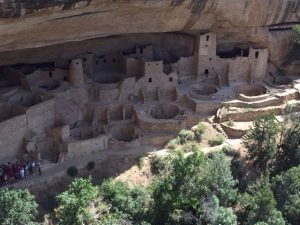
The incredible Cliff Palace in Mesa Verde National Park.
At the park’s Visitor Center a helpful ranger convinced us that the strenuous hiking and climbing required to go inside some of the dwellings was not for us. We’re both, uh, a bit older, and most of the park is over 7,000 feet in elevation, something with which we were already struggling. No matter; there were great views from overlooks, and we did not feel cheated in experiencing the awesome power of this place.
About forty-five minutes into the park we stopped at the Chapin Mesa Archaeological Museum, where an excellent video offered a history of Mesa Verde and its long-time inhabitants. A nearby trail led us to an overlook, where we could see the Spruce Tree House. Because of safety concerns related to rock slides the trail leading down to these dwellings was closed. Still, we had a great view from the overlook, where a ranger stood ready to answer any questions.
Without a doubt the “face” of Mesa Verde is the Cliff Palace. This “city,” which might have been a ceremonial and administrative center, contains about 150 rooms and twenty-three kivas. A marvel of engineering, the Cliff Palace is an incredible sight.
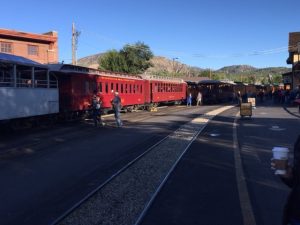
Boarding the train in Durango.
DON’T MISS THE TRAIN
My bride and I love riding on old trains, and the trip on the Durango-Silverton Narrow Gauge Railroad did not disappoint. We made reservations back in July, and some of the days that we requested were already sold out, even though they were mid-week and off-season. Fortunately, we scored a couple of round-trip seats on our last full day there.
We rode in a parlor car from the 1880s, and being a hoity-toity car (with a hoity-toity price tag) we had a knowledgeable guide who served us drinks and snacks, and told us wonderful stories. (She saved the ones about derailments for the return trip.) The trip starts in Durango (6,500 feet) and follows the Animas River through the San Juan Mountains up to the small mining town of Silverton (9,300 feet). The views were to die for, though the sharp curves around the sides of the cliffs gave us a few OMG moments.
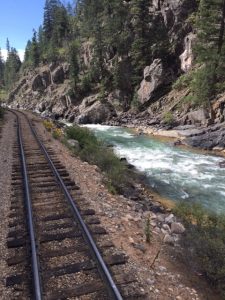
The train never veered far from the Animas River.
The ride up to Silverton took four hours, a half-hour longer than usual due to some work on the tracks. We had ninety minutes, rather than the usual two hours, to have lunch and do some shopping in the neat old mining town, but we endured. The trip down the mountain was also four hours, for the same reason. No worries; we met some nice folks coming and going, and we loved the experience.
Yes, we came for Mesa Verde, but we discovered so much more along the River of Lost Souls. We might even have to go back for more. I highly recommend a visit to the Four Corners region.
SCENES FROM THE DURANGO-SILVERTON TRAIN:
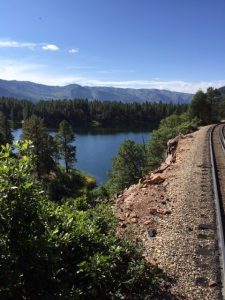

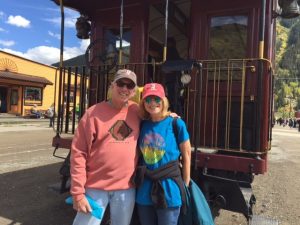
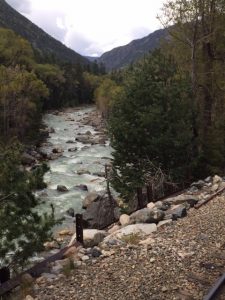

What a wonderful trip! I’ve seen many of these sights, but haven’t taken the train yet – next on the list!
Oh, you gotta ride the train. It is memorable!